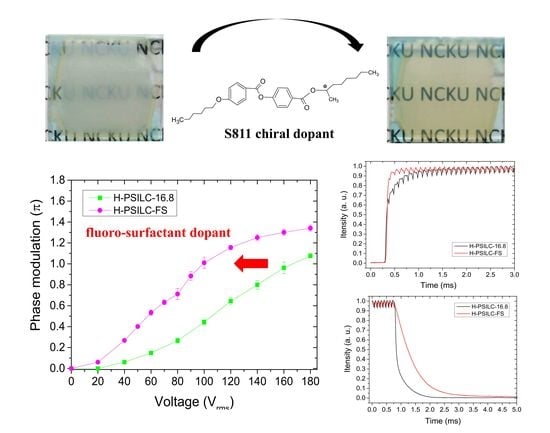Photo-Polymerization in Chiral Dopant Liquid Crystal Cells via Holographic Exposure to Fabricate Polarization-Independent Phase Modulator with Fast Optical Response
Abstract
:1. Introduction
2. Experimental
2.1. Materials
2.2. Holographic Exposure Setup
2.3. Measurement
3. Experimental Results
4. Discussion
5. Conclusions
Acknowledgments
Author Contributions
Conflicts of Interest
References
- Lin, G.J.; Chen, T.J.; Tsai, Y.W.; Lin, Y.T.; Wu, J.J.; Yang, Y.J. Performance enhancement using a non-uniform vertical electric field and polymer networks for in-plane switching of multi-pretilt, vertically aligned liquid crystal devices. Opt. Lett. 2014, 39, 6225–6228. [Google Scholar] [CrossRef] [PubMed]
- Wang, F.; Shao, L.; Bai, Q.; Che, X.; Liu, B.; Wang, Y. Photo-induced vertical alignment of liquid crystals via In situ polymerization initiated by polyimide containing benzophenone. Polymers 2017, 9, 233. [Google Scholar] [CrossRef]
- Chien, C.Y.; Wu, L.Y.; Sheu, C.R.; Hsu, C.J.; Huang, C.Y.; Chen, C.H.; Huang, L.Y.; Lee, S.L.; Tsai, W.C. Fast response time in liquid crystal cells doped with low concentrations of reactive mesogen via photopolymerization at low temperature. Opt. Mater. Express 2017, 7, 2740–2751. [Google Scholar] [CrossRef]
- Park, J.H.; Khoo, I.C. Liquid-crystal beam steering device with a photopolymer prism. Appl. Phys. Lett. 2005, 87, 091110. [Google Scholar] [CrossRef]
- McKnight, D.J.; Johnson, K.M.; Serati, R.A. 256 × 256 liquid-crystal-on-silicon spatial light modulator. Appl. Opt. 1994, 33, 2775–2784. [Google Scholar] [CrossRef] [PubMed]
- Hsu, C.J.; Sheu, C.R. Preventing occurrence of disclination lines in liquid crystal lenses with a large aperture by means of polymer stabilization. Opt. Express 2011, 19, 14999–15008. [Google Scholar] [CrossRef] [PubMed]
- Hikmet, R.A.M. From liquid crystalline molecules to anisotropic gels. Mol. Cryst. Liq. Cryst. 1991, 198, 357–370. [Google Scholar] [CrossRef]
- Dierking, I. Recent developments in polymer stabilised liquid crystals. Polym. Chem. 2010, 1, 1153–1159. [Google Scholar] [CrossRef]
- Chien, C.Y.; Hsu, C.J.; Chen, Y.W.; Tseng, S.H.; Sheu, C.R. Holographic polymer networks formed in liquid crystal phase modulators via a He–Ne laser to achieve ultra-fast optical response. Opt. Express 2016, 24, 7534–7542. [Google Scholar] [CrossRef] [PubMed]
- Lee, Y.H.; Gou, F.; Peng, F.; Wu, S.T. Hysteresis-free and submillisecond-response polymer network liquid crystal. Opt. Express 2016, 24, 14793–14800. [Google Scholar] [CrossRef] [PubMed]
- Lorenz, A.; Braun, L.; Kolosova, V. Continuous optical phase modulation in a copolymer network nematic liquid crystal. ACS Photonics 2016, 3, 1188–1193. [Google Scholar] [CrossRef]
- Wang, Q.; Kumar, S. Submillisecond switching of nematic liquid crystal in cells fabricated by anisotropic phase-separation of liquid crystal and polymer mixture. Appl. Phys. Lett. 2005, 86, 071119. [Google Scholar] [CrossRef]
- Song, D.H.; Lee, S.R.; Yoon, T.H.; Kim, J.C. Multi-dimensional liquid crystal alignment effect of polymer wall on vertically aligned liquid crystal cell. Jpn. J. Appl. Phys. 2010, 49, 011702. [Google Scholar] [CrossRef]
- Lee, K.M.; Tondiglia, V.P.; McConney, M.E.; Natarajan, L.V.; Bunning, T.J.; White, T.J. Color-tunable mirrors based on electrically regulated bandwidth broadening in polymer-stabilized cholesteric liquid crystals. ACS Photonics 2014, 1, 1033–1041. [Google Scholar] [CrossRef]
- Jiang, J.; McGraw, G.; Ma, R.; Brown, J.; Yang, D.K. Selective scattering polymer dispersed liquid crystal film for light enhancement of organic light emitting diode. Opt. Express 2017, 25, 3327–3335. [Google Scholar] [CrossRef] [PubMed]
- Chien, C.Y.; Sheu, C.R. Small dosage of holographic exposure via a He–Ne laser to fabricate tunable liquid crystal phase gratings operated with low electric voltages. Liq. Cryst. 2017, 44, 854–862. [Google Scholar] [CrossRef]
- Chien, C.Y.; Li, C.H.; Sheu, C.R. An electrically tunable liquid crystal lens with coaxial bi-focus and single focus switching modes. Crystals 2017, 7, 209. [Google Scholar] [CrossRef]
- Yang, D.K.; Chien, L.C.; Doane, J.W. Cholesteric liquid crystal/polymer dispersion for haze-free light shutters. Appl. Phys. Lett. 1992, 60, 3102–3104. [Google Scholar] [CrossRef]
- Murray, J.; Ma, D.; Munday, J.N. Electrically controllable light trapping for self-powered switchable solar windows. ACS Photonics 2016, 4, 1–7. [Google Scholar] [CrossRef]
- Lucchetta, D.E.; Karapinar, R.; Manni, A.; Simoni, F. Phase-only modulation by nanosized polymer-dispersed liquid crystals. J. Appl. Phys. 2002, 91, 6060–6065. [Google Scholar] [CrossRef]
- Ren, H.; Lin, Y.H.; Fan, Y.H.; Wu, S.T. Polarization-independent phase modulation using a polymer-dispersed liquid crystal. Appl. Phys. Lett. 2005, 86, 141110. [Google Scholar] [CrossRef]
- Ren, H.; Lin, Y.H.; Wen, C.H.; Wu, S.T. Polarization-independent phase modulation of a homeotropic liquid crystal gel. Appl. Phys. Lett. 2005, 87, 191106. [Google Scholar] [CrossRef]
- Lin, Y.H.; Ren, H.; Fan, Y.H.; Wu, Y.H.; Wu, S.T. Polarization-independent and fast-response phase modulation using a normal-mode polymer-stabilized cholesteric texture. J. Appl. Phys. 2005, 98, 043112. [Google Scholar] [CrossRef]
- Kobashi, J.; Kim, H.; Yoshida, H.; Ozaki, M. Polarization-independent submillisecond phase modulation utilizing polymer/short-pitch cholesteric liquid crystal composite. Opt. Lett. 2015, 40, 5363–5366. [Google Scholar] [CrossRef] [PubMed]
- Kikuchi, H.; Yokota, M.; Hisakado, Y.; Yang, H.; Kajiyama, T. Polymer-stabilized liquid crystal blue phases. Nat. Mater. 2002, 1, 64–68. [Google Scholar] [CrossRef] [PubMed]
- Yan, J.; Xing, Y.; Guo, Z.; Li, Q. Low voltage and high resolution phase modulator based on blue phase liquid crystals with external compact optical system. Opt. Express 2015, 23, 15256–15264. [Google Scholar] [CrossRef] [PubMed]
- Lin, Y.H.; Chen, H.S.; Lin, H.C.; Tsou, Y.S.; Hsu, H.K.; Li, W.Y. Polarizer-free and fast response microlens arrays using polymer-stabilized blue phase liquid crystals. Appl. Phys. Lett. 2010, 96, 113505. [Google Scholar] [CrossRef]
- Chen, K.M.; Gauza, S.; Xianyu, H.; Wu, S.T. Submillisecond gray-level response time of a polymer-stabilized blue-phase liquid crystal. J. Disp. Techol. 2010, 6, 49–51. [Google Scholar] [CrossRef]
- Yan, J.; Rao, L.; Jiao, M.; Li, Y.; Cheng, H.C.; Wu, S.T. Polymer-stabilized optically isotropic liquid crystals for next-generation display and photonics applications. J. Mater. Chem. 2011, 21, 7870–7877. [Google Scholar] [CrossRef]
- Oton, E.; Netter, E.; Nakano, T.; Inoue, F. Monodomain blue phase liquid crystal layers for phase modulation. Sci. Rep. 2017, 7, 44575. [Google Scholar] [CrossRef] [PubMed]
- Zhu, J.L.; Ni, S.B.; Song, Y.; Zhong, E.W.; Wang, Y.J.; Chen, C.P.; Ye, Z.; He, G.; Wu, D.Q.; Song, X.L.; et al. Improved Kerr constant and response time of polymer-stabilized blue phase liquid crystal with a reactive diluent. Appl. Phys. Lett. 2013, 102, 071104. [Google Scholar] [CrossRef]
- Xiang, J.; Lavrentovich, O.D. Blue-phase-polymer-templated nematic with sub-millisecond broad-temperature range electro-optic switching. Appl. Phys. Lett. 2013, 103, 051112. [Google Scholar] [CrossRef]
- Haseba, Y.; Kikuchi, H.; Nagamura, T.; Kajiyama, T. Large electro-optic Kerr effect in nanostructured chiral liquid-crystal composites over a wide temperature range. Adv. Mater. 2005, 17, 2311–2315. [Google Scholar] [CrossRef]
- Haseba, Y.; Kikuchi, H. Optically isotropic chiral liquid crystals induced by polymer network and their electro-optical behavior. Mol. Cryst. Liq. Cryst. 2007, 470, 1–9. [Google Scholar] [CrossRef]
- Yang, Y.C.; Yang, D.K. Electro-optic Kerr effect in polymer-stabilized isotropic liquid crystals. Appl. Phys. Lett. 2011, 98, 023502. [Google Scholar] [CrossRef]
- Bunning, T.J.; Natarajan, L.V.; Tondiglia, V.P.; Sutherland, R.L. Holographic polymer-dispersed liquid crystals (H-PDLCs). Annu. Rev. Mater. Sci. 2000, 30, 83–115. [Google Scholar] [CrossRef]
- Nataj, N.H.; Mohajerani, E.; Jashnsaz, H.; Jannesari, A. Holographic polymer dispersed liquid crystal enhanced by introducing urethane trimethacrylate. Appl. Opt. 2012, 51, 697–703. [Google Scholar] [CrossRef] [PubMed]
- Cipparrone, G.; Mazzulla, A.; Russo, G. Diffraction from holographic gratings in polymer-dispersed liquid crystals recorded by means of polarization light patterns. Appl. Phys. Lett. 2001, 78, 1186–1188. [Google Scholar] [CrossRef]
- Infusino, M.; Ferraro, A.; De Luca, A.; Caputo, R.; Umeton, C. POLYCRYPS visible curing for spatial light modulator based holography. J. Opt. Soc. Am. B 2012, 29, 3170–3176. [Google Scholar] [CrossRef]
- Caputo, R.; De Sio, L.; Veltri, A.; Umeton, C.; Sukhov, A.V. Development of a new kind of switchable holographic grating made of liquid-crystal films separated by slices of polymeric material. Opt. Lett. 2004, 29, 1261–1263. [Google Scholar] [CrossRef] [PubMed]
- Caputo, R.; De Luca, A.; De Sio, L.; Pezzi, L.; Strangi, G.; Umeton, C.; Veltri, A.; Asquini, R.; d’Alessandro, A.; Donisi, D.; et al. POLICRYPS: A liquid crystal composed nano/microstructure with a wide range of optical and electro-optical applications. J. Opt. A Pure Appl. Opt. 2009, 11, 024017. [Google Scholar] [CrossRef]
- Beckel, E.R.; Natarajan, L.V.; Tondiglia, V.P.; Sutherland, R.L.; Bunning, T.J. Electro-optical properties of holographically patterned polymer-stabilized cholesteric liquid crystals. Liq. Cryst. 2007, 34, 1151–1158. [Google Scholar] [CrossRef]
- Chien, C.Y.; Sheu, C.R. Doping liquid crystal cells with photocurable monomer via holographic exposure to realize optical-scattering-free infrared phase modulators with fast response time. Crystals 2017, 7, 208. [Google Scholar] [CrossRef]
- Provenzano, C.; Pagliusi, P.; Cipparrone, G. Highly efficient liquid crystal based diffraction grating induced by polarization holograms at the aligning surfaces. Appl. Phys. Lett. 2006, 89, 121105. [Google Scholar] [CrossRef]
- Liu, K.; Xu, H.; Hu, H.; Gan, Q.; Cartwright, A.N. One-step fabrication of graded rainbow-colored holographic photopolymer reflection gratings. Adv. Mater. 2012, 24, 1604–1609. [Google Scholar] [CrossRef] [PubMed]
- Chen, W.R.; Hwang, J.C. The phase behaviour and optical properties of a nematic/chiral dopant liquid crystalline mixture system. Liq. Cryst. 2004, 31, 1539–1546. [Google Scholar] [CrossRef]
- Relaix, S.; Bourgerette, C.; Mitov, M. Broadband reflective liquid crystalline gels due to the ultraviolet light screening made by the liquid crystal. Appl. Phys. Lett. 2006, 89, 251907. [Google Scholar] [CrossRef]
- Relaix, S.; Bourgerette, C.; Mitov, M. Broadband reflective cholesteric liquid crystalline gels: Volume distribution of reflection properties and polymer network in relation with the geometry of the cell photopolymerization. Liq. Cryst. 2007, 34, 1009–1018. [Google Scholar] [CrossRef]
- Agez, G.; Relaix, S.; Mitov, M. Cholesteric liquid crystal gels with a graded mechanical stress. Phys. Rev. E 2014, 89, 022513. [Google Scholar] [CrossRef] [PubMed]
- Ma, R.Q.; Yang, D.K. Freedericksz transition in polymer-stabilized nematic liquid crystals. Phys. Rev. E 2000, 61, 1567. [Google Scholar] [CrossRef]
- Rajaram, C.V.; Hudson, S.D.; Chien, L.C. Effect of polymerization temperature on the morphology and electrooptic properties of polymer-stabilized liquid crystals. Chem. Mater. 1996, 8, 2451–2460. [Google Scholar] [CrossRef]
- Dierking, I.; Kosbar, L.L.; Lowe, A.C.; Held, G.A. Polymer network structure and electro-optic performance of polymer stabilized cholesteric textures I. The influence of curing temperature. Liq. Cryst. 1998, 24, 387–395. [Google Scholar] [CrossRef]
- Dierking, I. Fractal dimensionality of polymer networks formed by photopolymerization in a liquid crystal medium. J. Phys. D Appl. Phys. 2002, 35, 2520. [Google Scholar] [CrossRef]
- Dierking, I.; Kosbar, L.L.; Afzali-Ardakani, A.; Lowe, A.C.; Held, G.A. Network morphology of polymer stabilized liquid crystals. Appl. Phys. Lett. 1997, 71, 2454–2456. [Google Scholar] [CrossRef]
- Rajaram, C.V.; Hudson, S.D.; Chien, L.C. Morphology of polymer-stabilized liquid crystals. Chem. Mater. 1995, 7, 2300–2308. [Google Scholar] [CrossRef]
- Mitov, M.; Boudet, A.; Sopena, P.; Sixou, P. Morphological study of a chiral polymer network in a nematic liquid crystal from a concentration gradient. Liq. Cryst. 1997, 23, 903–910. [Google Scholar] [CrossRef]
- Zhao, X.; Liu, C.; Duan, J.; Zhang, D.; Luo, Y. Characterization of submillisecond response optical addressing phase modulator based on low light scattering polymer network liquid crystal. J. Appl. Phys. 2015, 117, 014501. [Google Scholar]
- Wang, H.; Wu, T.X.; Zhu, X.; Wu, S.T. Correlations between liquid crystal director reorientation and optical response time of a homeotropic cell. J. Appl. Phys. 2004, 95, 5502–5508. [Google Scholar] [CrossRef]
- Hikmet, R.A.M.; Boots, H.M.J. Domain structure and switching behavior of anisotropic gels. Phys. Rev. E 1995, 51, 5824. [Google Scholar] [CrossRef]
- Yan, J.; Cheng, H.C.; Gauza, S.; Li, Y.; Jiao, M.; Rao, L.; Wu, S.T. Extended Kerr effect of polymer-stabilized blue-phase liquid crystals. Appl. Phys. Lett. 2010, 96, 071105. [Google Scholar] [CrossRef]
- Yu, J.H.; Chen, H.S.; Chen, P.J.; Song, K.H.; Noh, S.C.; Lee, J.M.; Ren, H.; Lin, Y.H.; Lee, S.H. Electrically tunable microlens arrays based on polarization-independent optical phase of nano liquid crystal droplets dispersed in polymer matrix. Opt. Express 2015, 23, 17337–17344. [Google Scholar] [CrossRef] [PubMed]
- Hua, H.; Javidi, B. A 3D integral imaging optical see-through head-mounted display. Opt. Express 2014, 22, 13484–13491. [Google Scholar] [CrossRef] [PubMed]
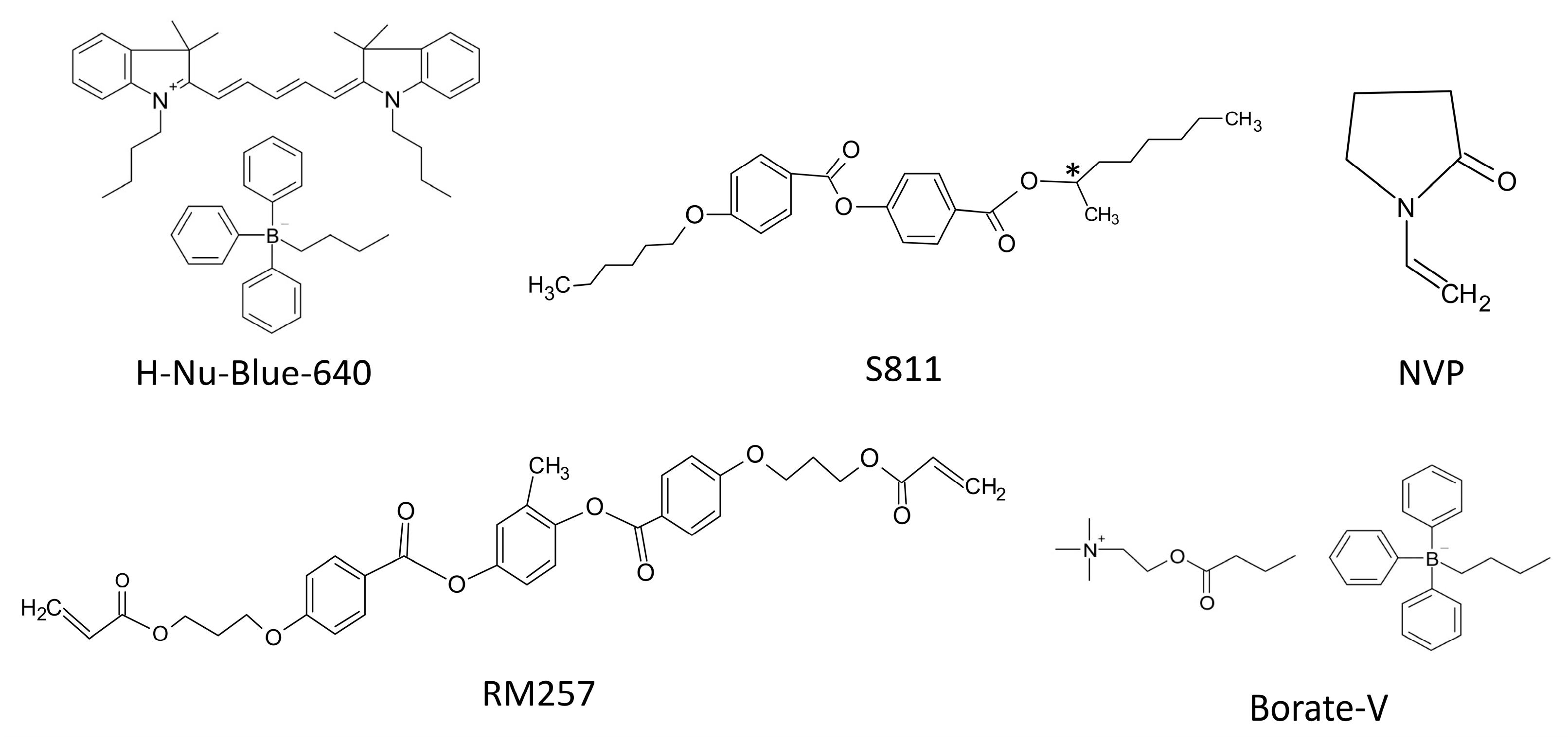

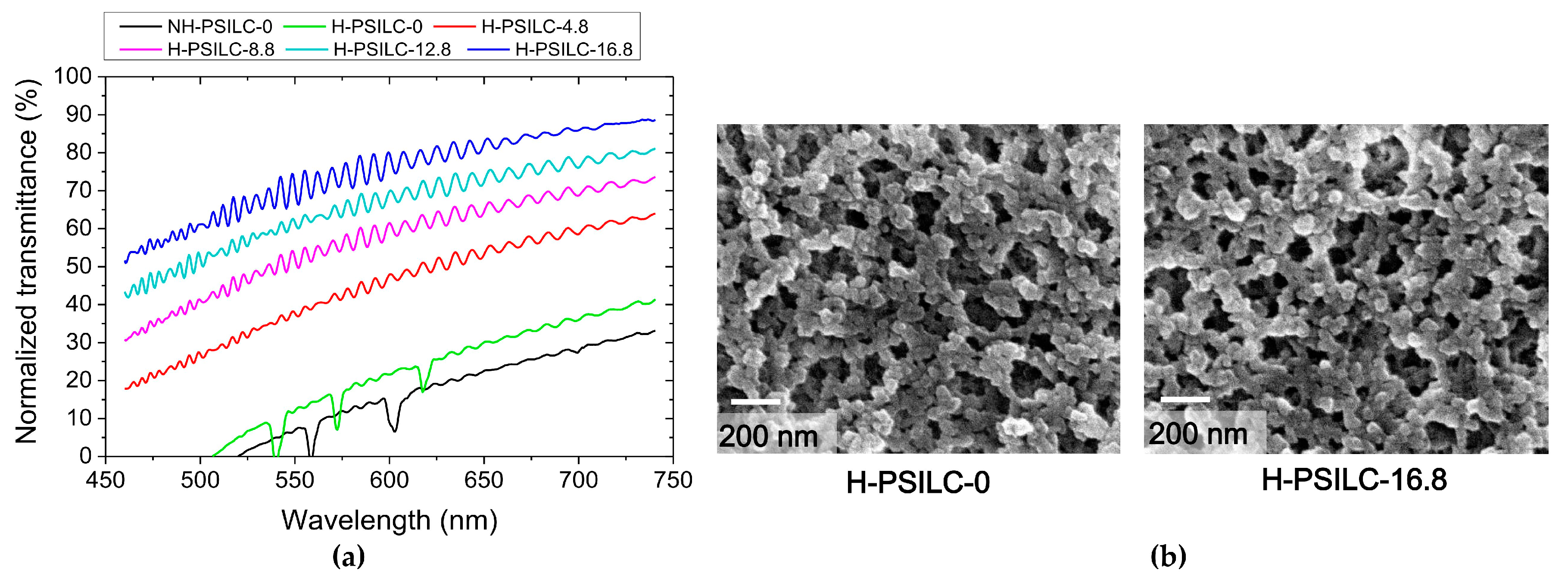
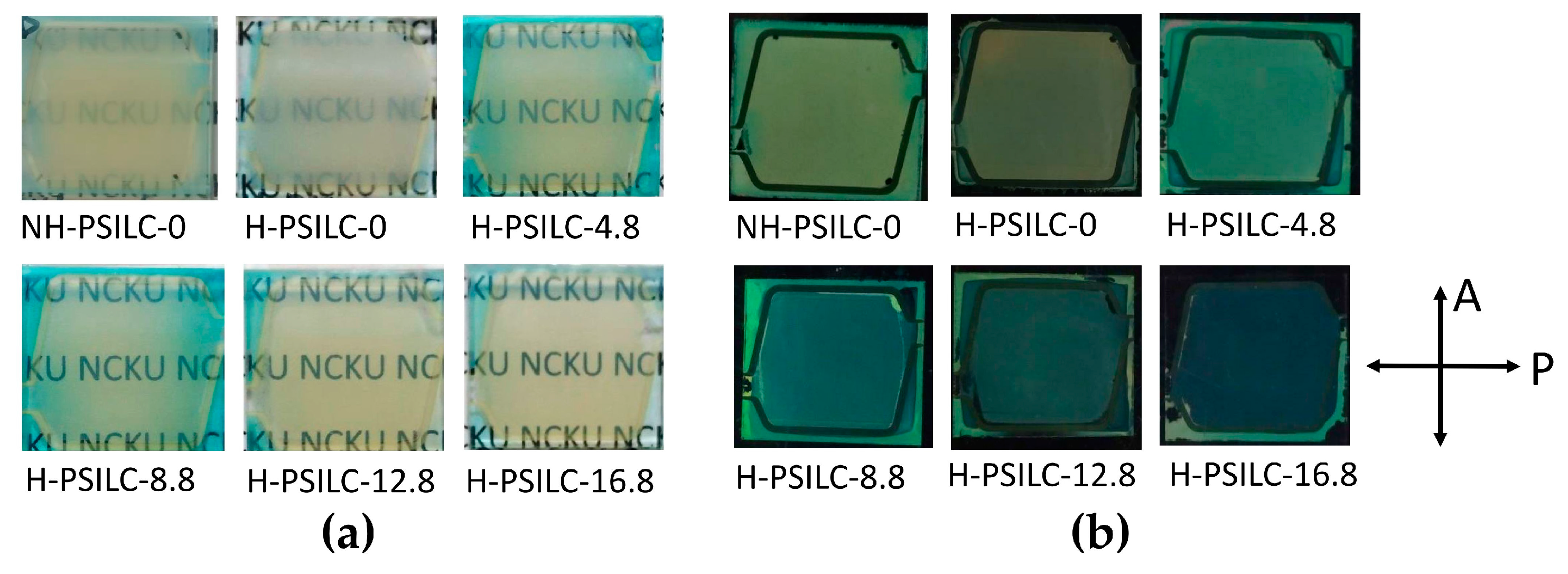
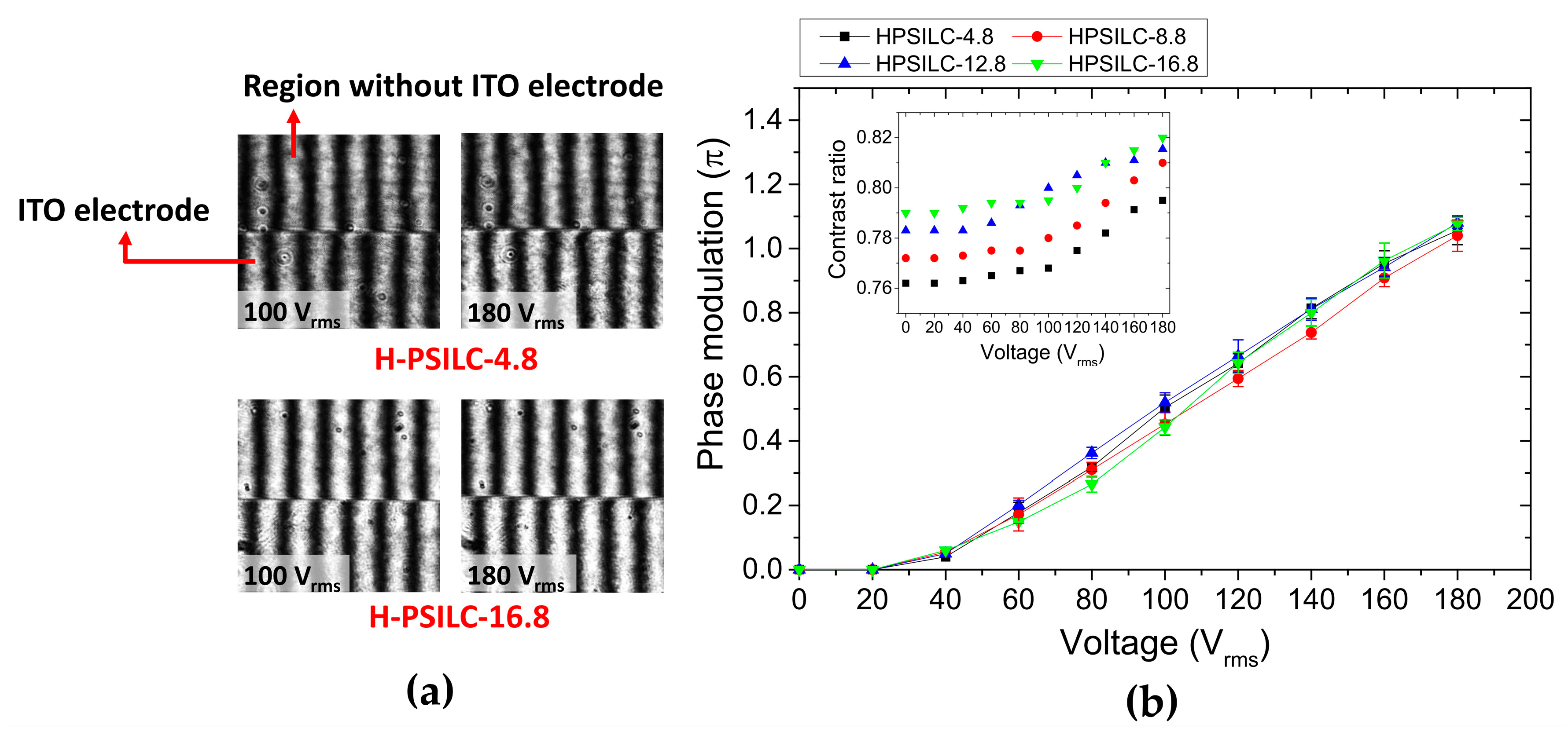
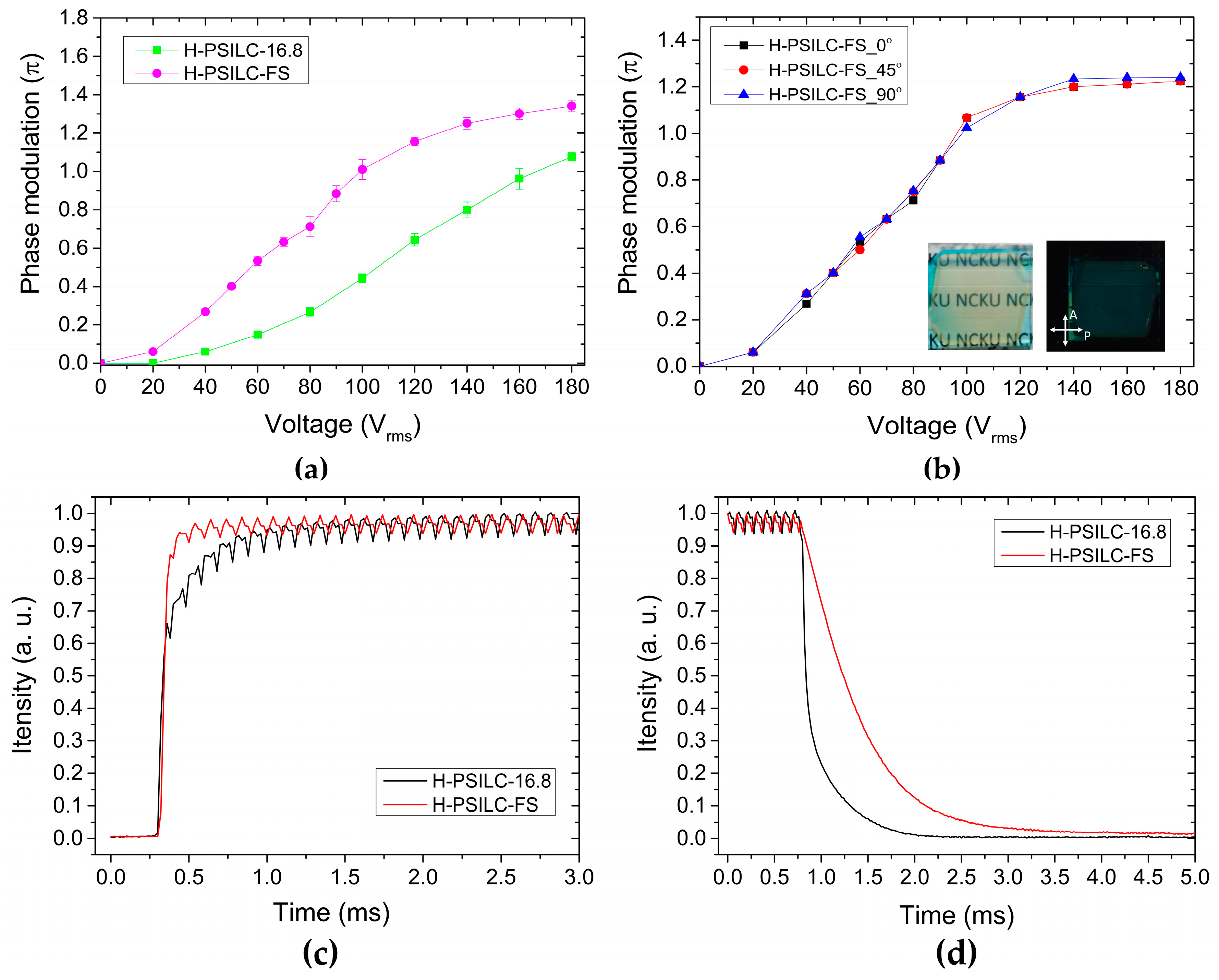
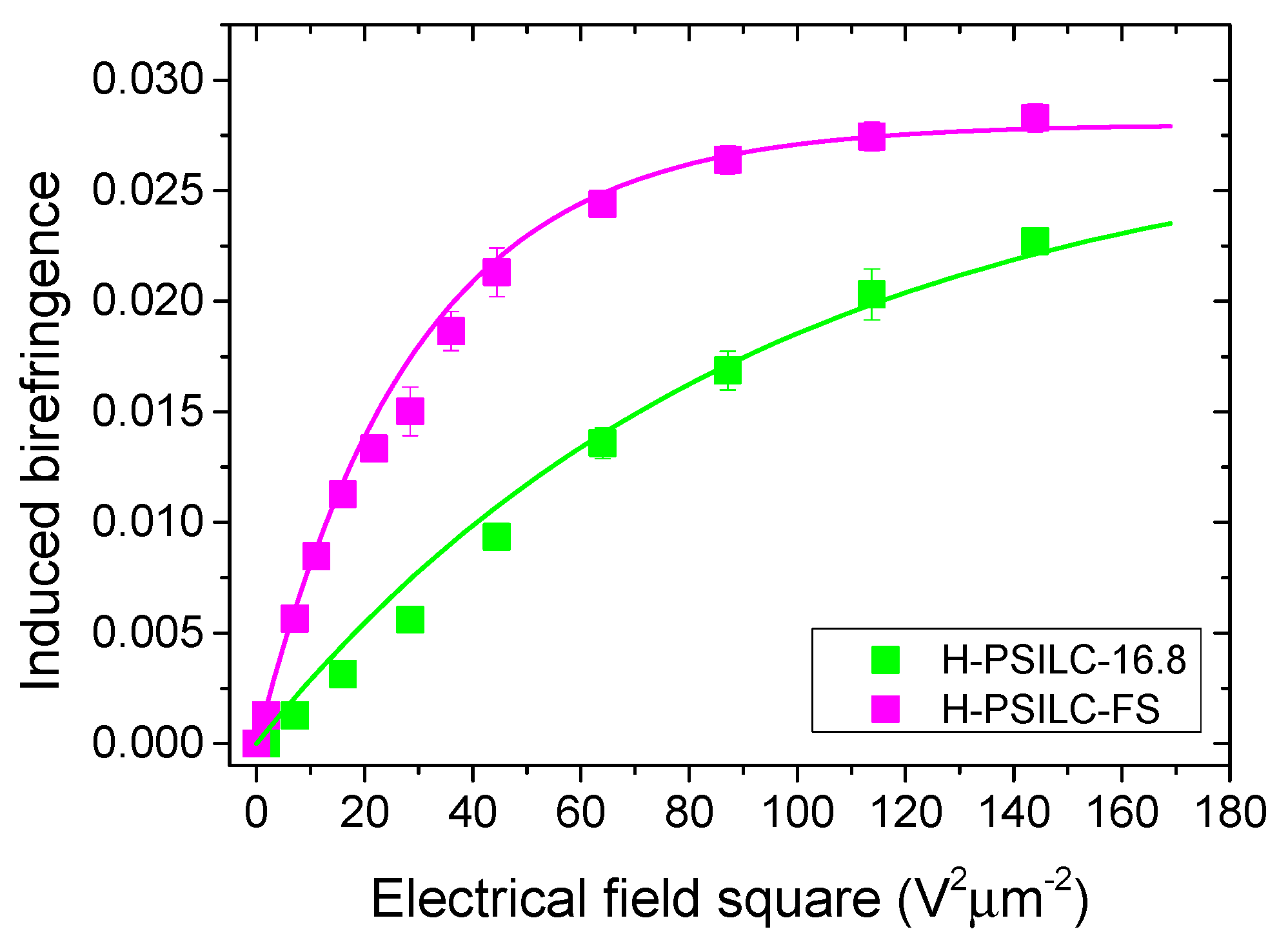
| Label of PSILC 1 Cells | HTG (wt %) | S811 (wt %) | FS3100 (wt %) | NVP (wt %) | RM257 (wt %) | H-Nu-Blue-640 (wt %) | Borate-V (wt %) |
|---|---|---|---|---|---|---|---|
| PSILC-0 | 84 | 0 | 0 | 2 | 13.5 | 0.25 | 0.25 |
| PSILC-4.8 | 79.2 | 4.8 | 0 | 2 | 13.5 | 0.25 | 0.25 |
| PSILC-8.8 | 75.2 | 8.8 | 0 | 2 | 13.5 | 0.25 | 0.25 |
| PSILC-12.8 | 71.2 | 12.8 | 0 | 2 | 13.5 | 0.25 | 0.25 |
| PSILC-16.8 | 67.2 | 16.8 | 0 | 2 | 13.5 | 0.25 | 0.25 |
| PSILC-FS | 65.2 | 16.8 | 2 | 2 | 13.5 | 0.25 | 0.25 |
© 2018 by the authors. Licensee MDPI, Basel, Switzerland. This article is an open access article distributed under the terms and conditions of the Creative Commons Attribution (CC BY) license (http://creativecommons.org/licenses/by/4.0/).
Share and Cite
Chien, C.-Y.; Sung, P.-K.; Sheu, C.-R. Photo-Polymerization in Chiral Dopant Liquid Crystal Cells via Holographic Exposure to Fabricate Polarization-Independent Phase Modulator with Fast Optical Response. Polymers 2018, 10, 315. https://doi.org/10.3390/polym10030315
Chien C-Y, Sung P-K, Sheu C-R. Photo-Polymerization in Chiral Dopant Liquid Crystal Cells via Holographic Exposure to Fabricate Polarization-Independent Phase Modulator with Fast Optical Response. Polymers. 2018; 10(3):315. https://doi.org/10.3390/polym10030315
Chicago/Turabian StyleChien, Chun-Yu, Pin-Kuan Sung, and Chia-Rong Sheu. 2018. "Photo-Polymerization in Chiral Dopant Liquid Crystal Cells via Holographic Exposure to Fabricate Polarization-Independent Phase Modulator with Fast Optical Response" Polymers 10, no. 3: 315. https://doi.org/10.3390/polym10030315




